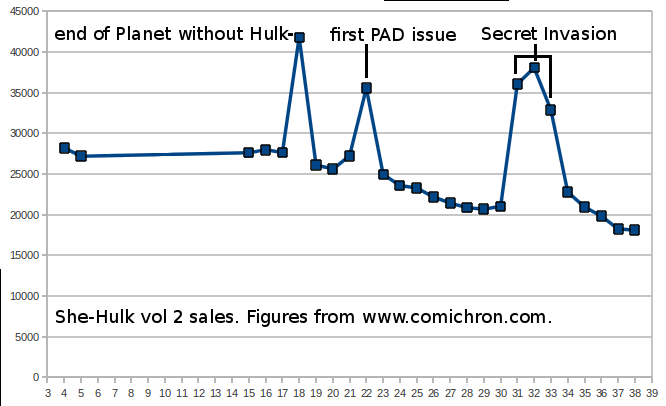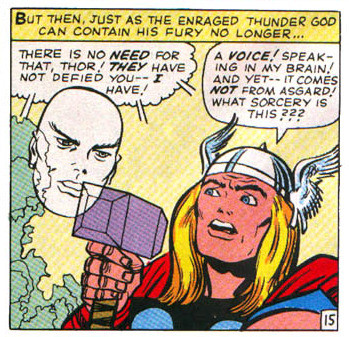So, Carol Danvers (a.k.a. Ms. Marvel a.k. Warbird, a.k.a. Binary), who we'll meet a few months down the line, is getting a haircut, and a
new solo series, as Captain Marvel. This means Marvel will have an ongoing female solo again, after
X-23 and
Ghost Rider were cancelled. X-Marathon approves of the new look and will be putting the book on its pull list.
As was noted a couple of months back, it's been a long time since Marvel didn't have an ongoing female solo - by my reckoning since October 1998 and the launch of Spider-Girl. Why is this? Well, poor sales, we're told. But essentially that's a tautology. The series did not succeed commercially because of poor sales. Well, yes. But why the poor sales? Is this because comics readers are inherently sexist? Because Marvel aren't doing enough promotion? Or just maybe it's a bit more complicated than that.
In the last ten years, there have been solo titles based around various female heroes - Spider-Girl, She-Hulk, Ms. Marvel, Mystique, Rogue, Black Widow, Spider-Woman. Of these the longest-running were the alternative-universe Spider-Girl (with 100 issues in its original volume), and then the 616 She-Hulk and Ms. Marvel, notching up 50 issues each in their mid-2000s series.
What these runs have in common is a single writer. Tom DeFalco wrote every single issue of Spider-Girl, Brian Reed wrote the entire run of Ms. Marvel, and She-Hulk didn't survive much more than a year after Dan Slott's run ended. She-Hulk is in fact Marvel's only recent attempt to hand over a female solo title between writers. Let's look at a chart.

Huh. Not great, eh. It had found pretty consistent level of about 27,000 under Slott, but after some initial interest it started falling under Peter David, and wasn't arrested by a crossover with his
X-Factor title for Secret Invasion. Given this, I can see why they might not have wanted to find a successor to Reed for Ms. Marvel a year later. But perhaps they should have tried anyway.
What's going on here is that there are about six or eight "core" Marvel characters that can permanently support an ongoing, and Marvel will try to find a creative team to take the character if it becomes vacant - the big three of Spider-Man, Hulk and Wolverine - the Avengers trio of Iron Man, Captain America, and Thor, and the more marginal cases of Daredevil and Punisher. These are the books with the huge issue numbers (they've all either been recently renumbered upwards, or relaunched at a new #1). The A-list consists of Marvel's solo characters from the 1960s with only Punisher and Wolverine having been successfully added subsequently.
Other characters with solo series rarely last more than a couple of years. In the past five years there have been solo series for the B-list male solo heroes of Ant-Man, Black Panther, Blade, Cable, Daken, Ghost Rider, Hawkeye, Hercules, Iron First, Moon Knight, and War Machine. None of them are being published today (bar Moon Knight, which is ending in a couple of issues). There's a few ones recently launched (Scarlet Spider, Venom and Winter Soldier), but I would be honestly surprised if these went on to long runs. The success of all these niche ongoings seems to be directly related to the creative team, and they often fail when that's changed, or sometimes they simply don't look for a replacement. In that context, Ms. Marvel and She-Hulk were very successful runs. As Marvel retreats into so-called "family branding", with most books called X-Men, Avengers, or associated with one of the Big Eight Marvel Characters in Pop Culture, the casualty is less scope for female solo ongoings. There's a bit of a random walk going on with the other titles, and that the number ended up being 0 for a few months rather than scraping in at 1 or 2, as it had managed essentially by chance since Ms. Marvel and She-Hulk were cancelled, was bound to happen sooner or later.
So, what's going on at the Distinguished Competition? They have five female solo titles in the New 52 - Wonder Woman, Supergirl, Batgirl, Batwoman, and Catwoman. Of these, Wonder Woman is that much more an important character to DC not because of modern decisions by the publisher, but by simple good fortune of her being a Golden Age character with continuous publication. She is not a "legacy" character or a member of a supporting cast given a spin-off book. Unlike the other four - three of which are Bat-family books. So I'd argue that it's not that DC's present management is necessarily any better at this, but they've been dealt a better historical situation.
What can be done? Well, launching a new Carol Danvers title is definitely a good start. She's the closest thing Marvel have to a female A-lister. Steering creative teams towards revamping female characters is a positive thing - if a relaunch can everyone very excited about Iron Fist, surely this can be done with anyone... And perhaps part of the answer is also events and the contents of the team books. Ms. Marvel had prominent roles in Civil War and Secret Invasion, as Iron Man's second-in-command. Siege and especially Fear Itself were more boys' clubs. Story points and premises for new runs often come out of these - Reed's Ms. Marvel itself launched from House of M. If in Fear Itself, it was She-Hulk who become the hammer-wielding worldbreaker of Nul instead of Hulk, would we be seeing a Jason Aaron-penned series about her redemptive quest now? And why are we seeing a Winter Soldier ongoing launch rather than a Black Widow? Because of Ed Brubaker, because of the story choices that were made ages back, when Bucky was picked as substitute Captain America rather than another member of the supporting cast, such as Sharon Carter (Agent 13).
The upcoming Avengers vs. X-Men series at least features Hope and Wanda prominently. They've cancelled Generation Hope - a semi-solo title - I suppose a Scarlet Witch ongoing launching out of that is too much to ask for, eh? But I suspect the sad fact is that this is all managed decline, and that there's simply never going to be another breakout character - nobody will ever join those six or eight characters that Marvel feels obliged to keep going no matter what. But there's certainly room, with a good push, for a midlist Captain Marvel title that will last a number of years.


